Keywords
|
| Energy meter, wireless data, data management, billing and payment |
INTRODUCTION
|
| World without Electricity are unimaginable. Countries development depends on per-capita consumptions. In India there are many sector which has attained a rapid development but only few developments are made in Electricity board sector. Traditional electro-mechanical meters, still widely used today, are prone to drift over temperature and time as a result of the analogue and mechanical nature of the components in these meters. Collection of meter readings is also inefficient, because a meter reader has to physically be on- site to take the readings. This method of collecting of meter readings becomes more problematic and costly when readings have to be collected from vast, and often scattered rural areas. Meter readers are reluctant to make the effort to travel to such areas and will often submit inaccurate estimations of the amount of electricity consumed. For households at the top of high buildings and luxury housing plots, traditional meter reading is highly inefficient. There exists chance for missing bills, absence of consumer etc[1]. Digital meters were placed in certain places which indicate voltage, current, power, time & date in liquid crystal display. Automatic meter reading is popular because of its remote nature of data collection. There are different technologies being used to capture and transfer data remotely, but the accuracy, speed, efficiency, reliability and costeffectiveness are the usual benefits properly achieved in this system but an additional facility for payment was also introduced. Automatic meter reading system consists of measuring sensors, microcontroller and wireless communication network. The meter reading and management of data are free from human error[3].After the measurement of readings the data is fed to remote location server which consists of software solution which generates bill and it will send back to the same protocol so the consumer can collect his bill in the meter display. By using a recharge card consumer can pay the bill with the help of keypad in the system. |
Existing Technologies
|
| Energy consumption is measured using various technologies. Bill for usage is generated and provided to the customer using certain methods. Payment is collected in electricity board from the customer. Recently, research into the field of Automatic Meter Reading System has continued to receive much attention in academia. |
| (i)Traditional Electro-mechanical meters where used to measure the energy consumption. It is an analog meter where readings are noted in the card by a person and the reading where taken to Electricity board station where the bill is generated for the consumption, consumer has to pay the bill for the usage in Electricity board station. Human error is main disadvantage of this method. |
| (ii)Electronic meters were introduced which has replaced the analog into digital system, but the procedure were same as electro-mechanical meter. Here the consumer can note down voltage, current, power, time & date this is the only advantage over electro-mechanical meter. |
| (iii)Developed a Bluetooth based system, were a method was introduced to retrieve data by means of wireless communication known as Automatic meter reading(AMR). AMR is a mechanism whereby the Energy meter sends the recorded power consumption of a household in the certain interval of time to a ‘wirelessly’ connected reader, which could be a personal computer[3]. The reading were noted in a database and bill will be generated. |
| (iv)Introduced a GSM based system, where Bluetooth technology was replaced by GSM technology, here the readings were send to remote location by using SMS and bill is generated and send to consumer mobile using GSM modem. Disadvantage of this method is the cost for sms and jam of network. |
| (v)Design of an Electric Energy Meter for long-distance data information transfers which is based upon GPRS is proposed, where the data is transferred by means of GPRS. |
Proposed System
|
| The system consists of Automatic meter reading facility with the help of voltage and current sensor, the value is fed to controller to calculate the usage of power. Then the data is fed to remote station server with the help of ZigBee. A software is created using .Net in the server which will generate the bill for our usage according to the tariff. A database is maintained in the server which consists of customer details and his consumption. Amount for usage is again fed to Energy meter display in home using same ZigBee network. Thus we can avoid human errors in measuring the readings. |
| o AMR for measuring consumption |
| o Microcontroller to calculate Energy consumption |
| o ZigBee to transfer data |
| o Display for readings and information |
| o Keypad for payment |
| EB card was introduced in this system which will resemble as top-up cards for mobile phones. According to usage of power we can purchase the card. Then we can enter the secret number in the card by using a keypad and send to server by using ZigBee network. Amount for usage will detected by the server and it will credit the amount if there is balance. Thus we be able pay the bill in our place. |
SYSTEM ARCHITECTURE
|
| This section describes the conceptual design of a low cost energy meter with payment facility (see Figure 1). As depicted in Figure 1, the proposed system has the facility for Automatic meter reading and payment of bill. Customer can pay the bill for the consumption using E.B card which is introduced for this design which is like recharge card for mobile phone usage. |
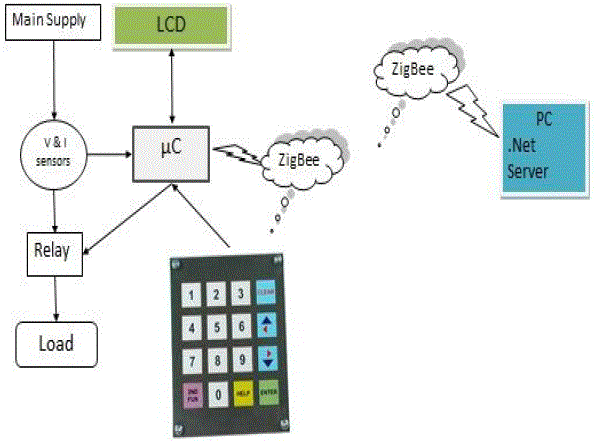 |
| Figure 1: Conceptual Architecture Overview |
Microcontroller
|
| This unit contains the software components such as the automatic energy meter system through which the consumption is calculated and fed to remote station. Here we used Atmel’s AT89S52 microcontroller which is having four ports consisting of 32 input/output pins. Here the microcontroller acts as the central processing unit (i.e.) brain of the system. The microcontroller is able to communicate when there is a need to access the network for sending or receiving data. Since the microcontroller is an electronic device, the signals that enter it must be electrical. In order to make an electrical or mechanical machine communicate with the microcontroller an interface has to be used. The microcontroller takes the data from the interface and makes some calculations if needed then translates the data into some commands so the module can understand it. The controller also takes the data from the module then translates the data to the interface to produce the bill. Then after producing the bill it will send it to microcontroller with the network communication and it will be displayed in LCD. |
ZigBee Technology
|
| ZigBee is a radio frequency (RF) communications standard based on IEEE 802.15.4. ZigBee is new wireless communication technology, representing a wireless sensor network which is highly reliable, secure, low datarate, low power consumption, low cost and fast reaction. The Zigbee coordinator is responsible for creating and maintaining the network. All communication between devices propagates through the coordinator to the destination device. The wireless nature of ZigBee helps overcome the intrusive installation problem with the existing systems identified earlier. The ZigBee standard theoretically provides 250kbps data rate, and as 40kbps can meet the requirements of most control systems, it is sufficient for controlling the system. The low installation and running cost offered by ZigBee helps tackle the expensive and complex architecture problems with existing systems, as identified earlier. |
Personal Computer (PC)
|
| Personal computer consist of necessary operating system which can control the software created and it acts as a server to receive and provide data for billing. This will generate bill according to tariff. This will contain all details of a customer. |
Keypad
|
| A Keypad is a set of buttons arranged in a block or “pad” which usually bear digits which is known as numeric keypad. This keypad helps the customer to enter the secret code for the payment. |
Liquid Crystal Display (LCD)
|
| A liquid-crystal display (LCD) is a flat panel display, electronic visual display, or video display that uses the light modulating properties of liquid crystals. Liquid crystals do not emit light directly. LCDs are available to display arbitrary images such as preset words and digits. Thus we can able to get information by the display. |
Voltage and Current sensors
|
| Voltage and Current sensor are used to detect the flow of energy and it helps to calculate the power consumption |
SYSTEM IMPLEMENTATION
|
Hardware Implementation
|
| Voltage divider circuit and Current divider circuit are used to note down the voltage and current value of consumption, the phase angle is also noted and they are fed to microcontroller to calculate the power consumption using our program which is burn into the microcontroller, the reading are also displayed in the LCD, where we can able to collect information on voltage, current, power, readings etc., thus we can measure energy consumption. |
| By using ZigBee network the reading is send to remote location server, where a software program is created using GUI. Here the tariff for our usage is given which helps to generate bill for the usage. Then it is send back to energy meter using ZigBee network and it is displayed in LCD. |
| After getting the bill in LCD we can user E.B card to settle our bill which is introduced for this system, here the card contains some secret numbers which possess certain amount according to our bill we can pay the amount using the card. For example if our consumption is about Rs.200, we can buy a card for Rs.200 which will contain a secret code number. Then we should type that number using keypad and press a button to send to the server. By receiving the code it will decode the code in amount and thus it will clear our account on payment. |
Software Implementation
|
| The Software developed here is with GUI which makes easier to work on it. It is created using .NET. It has database management system which helps to maintain the data. Customer can directly pay the amount in Electricity Board station where this software helps to complete the payment. |
CONCLUSION
|
| This paper presents the design and the implementation of an interactive ZigBee based energy meter. As the mobility in the world increases, the need for communicating to remote locations also increases. The use of ZigBee communications technology helps lower the expense of the system and the intrusiveness of the respective system installation. This system helps to pay our electricity bill in our own place. |
Simulation Results
|
| Simulation is done in Proteus software. Simulation output represents the voltage, current, unit consumption and cost for consumption. By means of keypad we can enter the secret code for the amount to be paid. Where Programming is done in MikroC Pro and hex file is generated. |
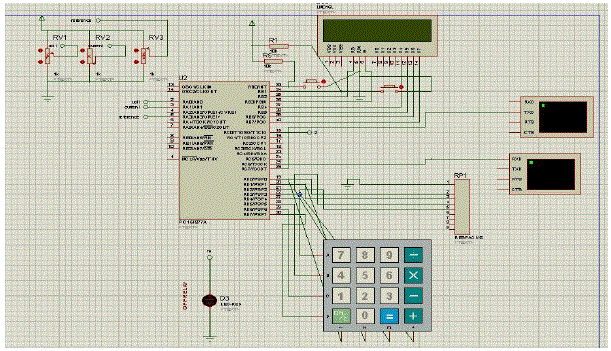 |
| Figure 2 : Simulation Circuit |
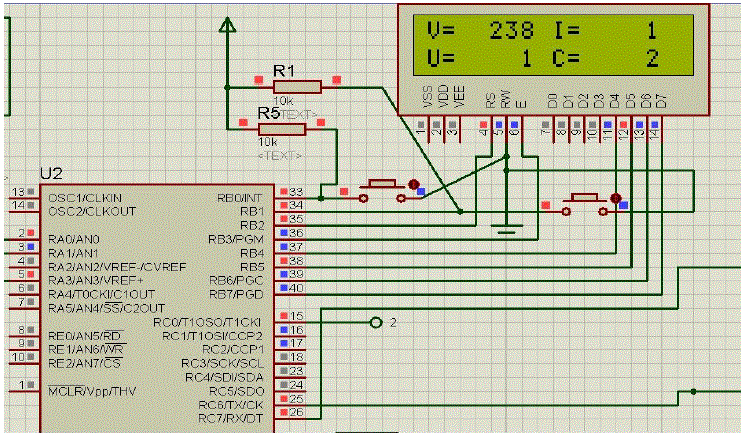 |
| Figure 3: Output representing voltage, current, units& cost |
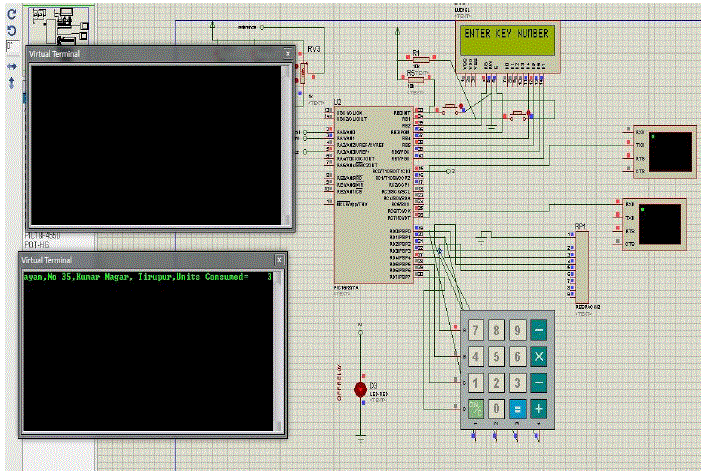 |
| Figure 4 : Using Keypad we can enter the key number |
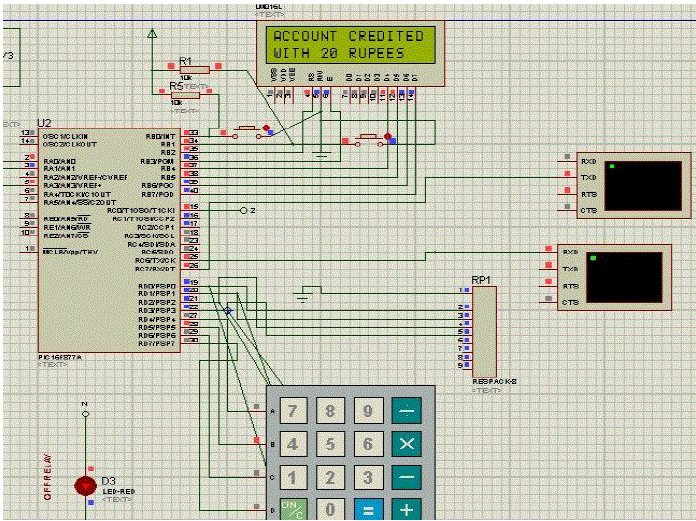 |
| Figure 5 : Amount credited to your account |
| The key number can be pressed by using keypad and then the key will be send to remote location station where the key number will be decoded and the amount for the key number will be credited to your account. If there is any balance in your account it will be detected for next month charge and it will add the cost to your account if there is no balance. |
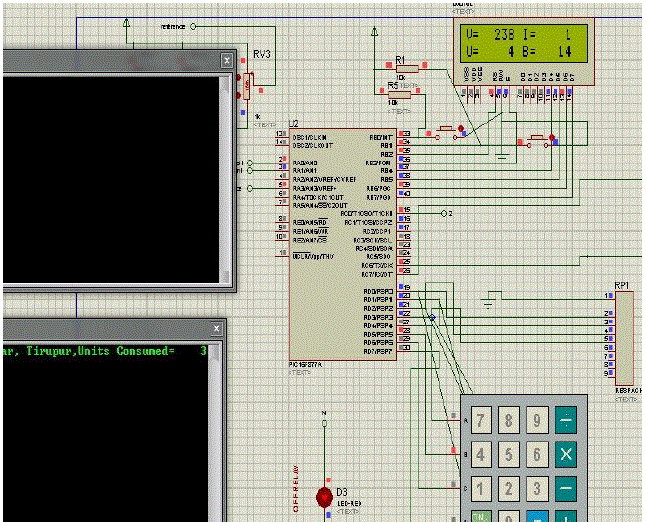 |
| Figure 6 : Represent the balance amount after credit |
ACKNOWLEDGMENT
|
| I wish to thank our Professor E. Santhi Bannari Amman institute of Technology for his support and encouragement. |
References
|
- Yujun Bao and Xiaoyan Jiang, “Design of electric Energy Meter for long-distance data information transfers which based upon GPRS”, ISA2009. International Workshop on Intelligent Systems and Applications,2009
- Ashna.K and Sudhish N George, "GSM based automatic energy meter reading system" IEEE 2013.
- Tanmoy Maity and Partha Sarathi Das, "Intelligent online measurement and management of energy meter data through advanced wireless network" IEEE 2011
- B.S.Koay, S.S.Cheah, Y.H.Sng, P.H.J.Chong, and H.W.Kuek, "Design and Implementation of bluetooth energy meter" IEEE 2003
- Vivek Kumar Sehgal,Nitesh Panda, Nipun Rai Handa, “Electronic Energy Meter with instant billing”,UKSim Fourth European Modelling Symposium on Computer Modelling and Simulation.
|